Don't wanna be here? Send us removal request.
Text
Peer-graded Assignment: Creating graphs for your data
Objective of this study is to create univariate to understand counts of response variable and explanatory variables. Crater depth ('DEPTH_RIMFLOOR_TOPOG) has been chosen as response variable and “'LATITUDE_CIRCLE_IMAGE”, “LONGITUDE_CIRCLE_IMAGE” & “DIAM_CIRCLE_IMAGE”are chosen as explanatory variables. Univariate and bivariate plots are generated for relationship interpretation among variables.
Summary:
Univariate plots on explanatory variables are presented in first three Figure presented the subsequent report. Univariate plots show that all three explanatory variables are almost equally distributed among 4 quartiles. Bivariate plots are generated to understand the association between explanatory and response variables. Last three figure represent relationship of response variable with all three explanatory variables. Bivariate plot signifies variability of response among 4 quartiles.
Details of the Python script used in this study is documented towards the end of this document.
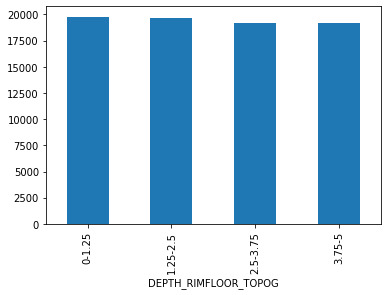
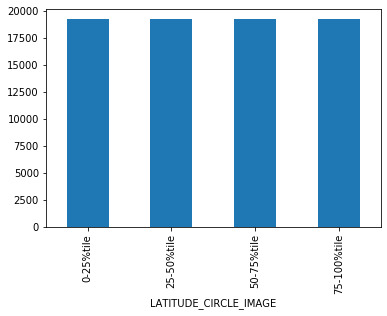
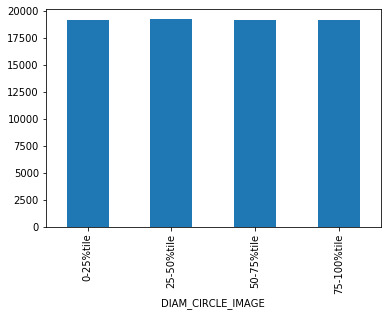
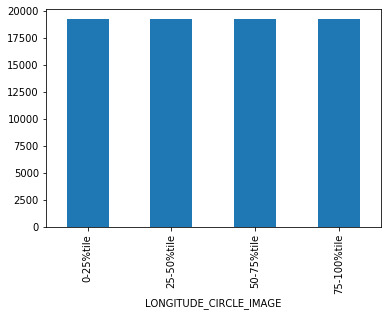
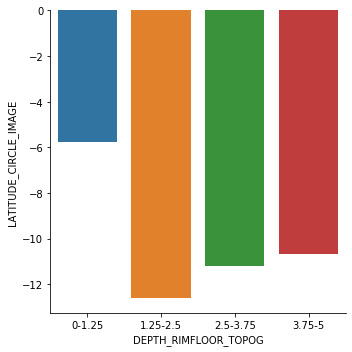
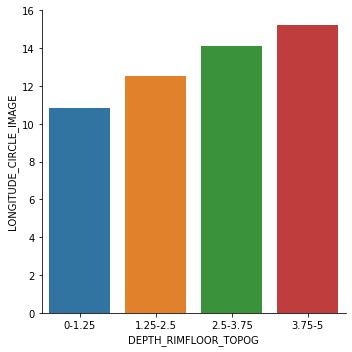
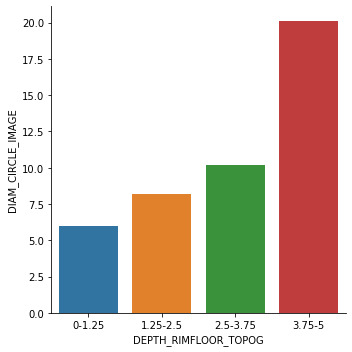
PYTHON SCRIPT
"""
# -*- coding: utf-8 -*-
"""
Spyder Editor
This is a temporary script file.
"""
import pandas as pd
import numpy as np
import seaborn as sns
import matplotlib.pyplot as plt
# load Mars crater dataset
data = pd.read_csv('marscrater_pds.csv',low_memory=False)
pd.set_option('display.float_format', lambda x:'%f'%x)
# display summary statistics about the data
print("Statistics for RIM DEPTH raw data")
print(data['DEPTH_RIMFLOOR_TOPOG'].describe())
# subset data for crater depth, negative and zero data's are ignored
data_neg = data[(data['DEPTH_RIMFLOOR_TOPOG']<0)]
data_datum = data[(data['DEPTH_RIMFLOOR_TOPOG']==0)]
data_depth = data[(data['DEPTH_RIMFLOOR_TOPOG']>0)]
print("Statistics for crater depth")
print(data_depth['DEPTH_RIMFLOOR_TOPOG'].describe())
####Univariate plot,LATITUDE_CIRCLE_IMAGE#####################
sub0 = data_depth.copy()
sub0['LATITUDE_CIRCLE_IMAGE'] = pd.qcut(sub0.LATITUDE_CIRCLE_IMAGE, 4, labels=["0-25%tile","25-50%tile","50-75%tile","75-100%tile"])
print("Counts for crater LATITUDE splitted in 4 groups: 0-25%tile, 25-50%tile, 50-75%tile, 75-100%tile")
sub0grp = sub0.groupby('LATITUDE_CIRCLE_IMAGE').size()
print(sub0grp)
sub0grp.plot.bar()
#####Univariate plot,LONGITUDE_CIRCLE_IMAGE##########################
sub1 = data_depth.copy()
sub1['LONGITUDE_CIRCLE_IMAGE'] = pd.qcut(sub1.LONGITUDE_CIRCLE_IMAGE, 4, labels=["0-25%tile","25-50%tile","50-75%tile","75-100%tile"])
print("Counts for crater LONGITUDE splitted in 4 groups: 0-25%tile, 25-50%tile, 50-75%tile, 75-100%tile")
sub1grp = sub1.groupby('LONGITUDE_CIRCLE_IMAGE').size()
print(sub1grp)
sub1grp.plot.bar()
###Univariate plot,DIAM_CIRCLE_IMAGE######################
sub3 = data_depth.copy()
sub3['DIAM_CIRCLE_IMAGE'] = pd.qcut(sub3.DIAM_CIRCLE_IMAGE, 4, labels=["0-25%tile","25-50%tile","50-75%tile","75-100%tile"])
print("Counts for crater DIAM splitted in 4 groups: 0-25%tile, 25-50%tile, 50-75%tile, 75-100%tile")
sub3grp = sub3.groupby('DIAM_CIRCLE_IMAGE').size()
print(sub3grp)
sub3grp.plot.bar()
######### Univariate plot,DEPTH_RIMFLOOR ##########
sub2 = data_depth.copy()
sub2['DEPTH_RIMFLOOR_TOPOG'] = pd.qcut(sub2.DEPTH_RIMFLOOR_TOPOG, 4, labels=["0-1.25","1.25-2.5","2.5-3.75","3.75-5"])
print("Counts for age splitted in 4 groups: 0-1.25, 1.25-2.5, 2.5-3.75, 3.75-5")
sub2grp = sub2.groupby('DEPTH_RIMFLOOR_TOPOG').size()
print(sub2grp)
sub2grp.plot.bar()
##Bivariate plot for association of crater depth with crater latitude
sns.factorplot(x='DEPTH_RIMFLOOR_TOPOG', y='LATITUDE_CIRCLE_IMAGE', data=sub2, kind="bar", ci=None)
plt.xlabel('DEPTH_RIMFLOOR_TOPOG')
plt.ylabel('LATITUDE_CIRCLE_IMAGE')
###Bivariate plot for association of crater depth with crater longitude
sns.factorplot(x='DEPTH_RIMFLOOR_TOPOG', y='LONGITUDE_CIRCLE_IMAGE', data=sub2, kind="bar", ci=None)
plt.xlabel('DEPTH_RIMFLOOR_TOPOG')
plt.ylabel('LONGITUDE_CIRCLE_IMAGE')
# #Bivariate plot for association of crater depth with crater diameter
sns.factorplot(x='DEPTH_RIMFLOOR_TOPOG', y='DIAM_CIRCLE_IMAGE', data=sub2, kind="bar", ci=None)
plt.xlabel('DEPTH_RIMFLOOR_TOPOG')
plt.ylabel('DIAM_CIRCLE_IMAGE')
0 notes
Text
Peer-graded Assignment: Making Data Management Decisions
Objective of this study is to study the decisions about identified data variables. Crater depth statistics helped to identify data abnormality and helped to clear the dataset to be used. Crater depth with negative value and zeros are not used for this study. First data are cleaned to have logical crater depth and associated variables. Variable’s identified for this study are Crater latitude circle, crater longitude circle and crater diameter.
Insights on variables
Distribution counts and frequencies of each variables are calculated to fletch insights from variables. New variables are generated from the existing variables. Details calculations are presented in subsequent document. Python script is also embedded in this content. Followings are the key insights from variables:
1. Crater latitude circle (LATITUDE_CIRCLE_IMAGE) and Crater longitude circle (LONGITUDE_CIRCLE_IMAGE) is ranged from positive value to negative value. Negative and positive signifies direction of data and hence they are considered as new variables
New variable creation from variables
As Crater latitude circle (LATITUDE_CIRCLE_IMAGE) and Crater longitude circle (LONGITUDE_CIRCLE_IMAGE) had data ranges from positive value to negative value, these two variables are segregated to generates new variables. Crater diameter (DIAM_CIRCLE_IMAGE) is range only positive value and hence no new variable is generated from this variable. Details of the findings are documented in the following content. Python script is also embedded in this content
Followings are the key finding from the distribution study:
1. Segregated positive and negative of each variable (LATITUDE_CIRCLE_IMAGE & LONGITUDE_CIRCLE_IMAGE) to create new variables.
Summary of Frequency distributions:
Frequency distribution of all three variables are calculated to understand the data patters and subsequent data segregation to create new variables. Details of the findings on frequency distributions are documented in the following content. Python script is also embedded in this content. Followings re the key finding from the distribution study:
1. Distribution of Crater latitude circle (LATITUDE_CIRCLE_IMAGE) signifies that its value can vary from -68.6 to +50.4. Data sets are segregated in 5 bins to understand distributions. Majority of the data is falling in the range -20.9 to 2.8. Details of the study presented in the subsequent content.
2. Distribution of Crater longitude circle (LONGITUDE_CIRCLE_IMAGE) signifies that its value can vary from -174.1 to 169.2. Data sets are segregated in 5 bins to understand distributions. Majority of the data is falling in the range -36.5 to 32.0. Details of the study presented in the subsequent content.
3. Distribution of Crater diameter (DIAM_CIRCLE_IMAGE) signifies that its value can vary from -34.7 to 312.4. Data sets are segregated in 5 bins to understand distributions. Majority of the data is falling in the range 34.7 to 90.4. Details of the study presented in the subsequent content.
Statistics for RIM DEPTH raw data
count 384343.000000
mean 0.075838
std 0.221518
min -0.420000
25% 0.000000
50% 0.000000
75% 0.000000
max 4.950000
Counts for deep crater Depth
counts percentages
4.750000 1 0.015385
2.720000 1 0.015385
3.030000 1 0.015385
2.940000 1 0.015385
2.560000 4 0.061538
2.590000 3 0.046154
2.870000 1 0.015385
4.010000 1 0.015385
2.620000 2 0.030769
4.720000 1 0.015385
Statistics for deep crater
count 65.000000
mean 2.913846
std 0.533141
min 2.510000
25% 2.560000
50% 2.760000
75% 2.980000
max 4.950000
Frequency for Latitude circle
Range Counts
(-68.61800000000001, -44.707] 8
(-44.707, -20.916] 13
(-20.916, 2.875] 24
(2.875, 26.666] 12
(26.666, 50.457] 8
Percentage for Latitude circle
Range Percentage
(-68.61800000000001, -44.707] 12.307692
(-44.707, -20.916] 20.000000
(-20.916, 2.875] 36.923077
(2.875, 26.666] 18.461538
(26.666, 50.457] 12.307692
Frequency for Longitude circle
Range Counts
(-68.61800000000001, -44.707] 8
(-44.707, -20.916] 13
(-20.916, 2.875] 24
(2.875, 26.666] 12
(26.666, 50.457] 8
Percentage for Longitude circle
Range Percentage
(-174.18, -105.217] 6.153846
(-105.217, -36.598] 26.153846
(-36.598, 32.02] 38.461538
(32.02, 100.639] 20.000000
(100.639, 169.258] 9.230769
Frequency for Crater Diameter
Range Counts
(34.732, 90.496] 45
(90.496, 145.982] 14
(145.982, 201.468] 3
(201.468, 256.954] 2
(256.954, 312.44] 1
Percentage for Crater Diameter
Range Percentage
(34.732, 90.496] 69.230769
(90.496, 145.982] 21.538462
(145.982, 201.468] 4.615385
(201.468, 256.954] 3.076923
(256.954, 312.44] 1.538462
PYTHON SCRIPT
"""
Spyder Editor
This is a temporary script file.
"""
import pandas as pd
import numpy as np
import seaborn as sns
import matplotlib.pyplot as plt
# load Mars crater dataset
data = pd.read_csv('marscrater_pds.csv',low_memory=False)
pd.set_option('display.float_format', lambda x:'%f'%x)
# display summary statistics about the data
print("Statistics for RIM DEPTH raw data")
print(data['DEPTH_RIMFLOOR_TOPOG'].describe())
# subset data for crater depth, negative and zero data's are ignored
data_neg = data[(data['DEPTH_RIMFLOOR_TOPOG']<0)]
data_datum = data[(data['DEPTH_RIMFLOOR_TOPOG']==0)]
data_depth = data[(data['DEPTH_RIMFLOOR_TOPOG']>0)]
# subset data for deep crater
deep_crater = data[(data['DEPTH_RIMFLOOR_TOPOG']>2.5)]
# identifying counts of deep crater depth
print("Counts for deep crater Depth")
crater_depth_freq = pd.concat(dict(counts = deep_crater["DEPTH_RIMFLOOR_TOPOG"].value_counts(sort=False, dropna=False), percentages = deep_crater["DEPTH_RIMFLOOR_TOPOG"].value_counts(sort=False, dropna=False, normalize=True)), axis=1)
print(crater_depth_freq.head(10))
# Rimfloor depth statistics
print("Statistics for deep crater")
print(deep_crater['DEPTH_RIMFLOOR_TOPOG'].describe())
#################################################################################
# LATITUDE_CIRCLE_IMAGE
#################################################################################
# frequency and percentage distritions for crater LATITUDE_CIRCLE_IMAGE (laci)
print('Frequency for Latitude circle')
print('Range Counts')
laci = deep_crater['LATITUDE_CIRCLE_IMAGE'].value_counts(sort=False,bins=5)
print(laci)
print('Percentage for Latitude circle')
print('Range Percentage')
placi = deep_crater['LATITUDE_CIRCLE_IMAGE'].value_counts(sort=False,bins=5,normalize=True)*100
print(placi)
#Creating new variables
lci_positive = deep_crater[(deep_crater['LATITUDE_CIRCLE_IMAGE'] > 0)]
lci_negative = deep_crater[(deep_crater['LATITUDE_CIRCLE_IMAGE'] < 0)]
#################################################################################
# LONGITUDE_CIRCLE_IMAGE
#################################################################################
# frequency and percentage distritions for crater LONGITUDE_CIRCLE_IMAGE (loci)
print('Frequency for Longitude circle')
print('Range Counts')
loci = deep_crater['LONGITUDE_CIRCLE_IMAGE'].value_counts(sort=False,bins=5)
print(laci)
print('Percentage for Longitude circle')
print('Range Percentage')
ploci = deep_crater['LONGITUDE_CIRCLE_IMAGE'].value_counts(sort=False,bins=5,normalize=True)*100
print(ploci)
#Creating new variables
loci_positive = deep_crater[(deep_crater['LONGITUDE_CIRCLE_IMAGE'] > 0)]
loci_negative = deep_crater[(deep_crater['LONGITUDE_CIRCLE_IMAGE'] < 0)]
############################################################################
# DIAM_CIRCLE_IMAGE
###########################################################################
# frequency and percentage distritions for Crater Diameter (dci)
print('Frequency for Crater Diameter')
print('Range Counts')
dci = deep_crater['DIAM_CIRCLE_IMAGE'].value_counts(sort=False,bins=5)
print(dci)
print('Percentage for Crater Diameter')
print('Range Percentage')
pdci = deep_crater['DIAM_CIRCLE_IMAGE'].value_counts(sort=False,bins=5,normalize=True)*100
print(pdci)
0 notes
Text
Peer-graded Assignment: Running Your First Program
Output with Frequency Tables at Crater depth for Crater latitude circle, crater longitude circle and crater diameter
Summary of Frequency Distributions
Crater depth statistics helped to identify data abnormality and helped to clear the dataset for frequency distribution. Statistics of crater depth helped to identify unrealistic crater depth and python scrip is used to remove those unrealistic data and clear the dataset. Variables identified for this study are “LATITUDE_CIRCLE_IMAGE”, “LONGITUDE_CIRCLE_IMAGE” and “DIAM_CIRCLE_IMAGE”. Frequency distributions are studied for each variable separately. Details of the findings are documented in the following content. Python script is also embedded in this content. Followings re the key finding from the distribution study:
1. Distribution of Crater latitude circle (LATITUDE_CIRCLE_IMAGE) is primarily dominated by data ranges -34.979 and -17.739 and maximum crater latitude circle found to be 86.7. Details of the study presented in the subsequent content.
2. Crater longitude circle (LONGITUDE_CIRCLE_IMAGE) is primarily dominated by data ranges -0.0 and 35.999 with count of 51633. Details of the study presented in the subsequent content.
3. Main distribution of Crater circle diameter (DIAM_CIRCLE_IMAGE) is in the range of -0.164 and 117.322. Details of the study presented in the subsequent content.
Statistics for RIM DEPTH raw data
count 384343.000000
mean 0.075838
std 0.221518
min -0.420000
25% 0.000000
50% 0.000000
75% 0.000000
max 4.950000
Counts for Rimfloor Depth
counts percentages
0.00 307529 0.800163
2.00 14 0.000036
0.22 1189 0.003094
0.19 1363 0.003546
0.43 684 0.001780
0.13 1763 0.004587
0.09 2008 0.005225
1.43 38 0.000099
0.27 1004 0.002612
0.44 698 0.001816
Statistics for RIM DEPTH with clear data
count 384333.000000
mean 0.075841
std 0.221518
min 0.000000
25% 0.000000
50% 0.000000
75% 0.000000
max 4.950000
Statistics for variable latitude circle
count 384333.000000
mean -7.199614
std 33.608671
min -86.700000
25% -30.935000
50% -10.079000
75% 17.222000
max 85.702000
Counts for Latitude circle
counts percentages
32.000 2 0.000005
2.000 1 0.000003
0.000 7 0.000018
-2.000 4 0.000010
-32.000 4 0.000010
-28.335 3 0.000008
-24.670 3 0.000008
-0.217 1 0.000003
-69.018 1 0.000003
-72.738 1 0.000003
Frequency for Latitude circle
(-86.873, -69.46] 8234
(-69.46, -52.22] 27317
(-52.22, -34.979] 45391
(-34.979, -17.739] 76206
(-17.739, -0.499] 74363
(-0.499, 16.741] 55366
(16.741, 33.981] 48216
(33.981, 51.222] 28934
(51.222, 68.462] 16474
(68.462, 85.702] 3832
Percentage for Latitude circle
(-86.873, -69.46] 2.142413
(-69.46, -52.22] 7.107638
(-52.22, -34.979] 11.810331
(-34.979, -17.739] 19.828118
(-17.739, -0.499] 19.348586
(-0.499, 16.741] 14.405737
(16.741, 33.981] 12.545371
(33.981, 51.222] 7.528367
(51.222, 68.462] 4.286387
(68.462, 85.702] 0.997052
Cumulative frequency of Latitude circle
[8234, 35551, 80942, 157148, 231511, 286877, 335093, 364027, 380501, 384333]
Cumulative percentage for Latitude circle
[2.1424129595949344, 9.25005138772887, 21.060382532855623, 40.88850033694739, 60.23708606859156, 74.64282276047074, 87.18819357172036, 94.71656089901205, 99.00294796439546, 100.0]
Statistics for variable longitude circle
count 384333.000000
mean 10.128091
std 96.642183
min -179.997000
25% -58.830000
50% 12.739000
75% 89.277000
max 179.997000
Counts for Longitude circle
counts percentages
64.000 2 0.000005
2.000 5 0.000013
-0.125 1 0.000003
0.000 3 0.000008
102.076 3 0.000008
102.424 2 0.000005
73.262 2 0.000005
47.992 2 0.000005
123.252 1 0.000003
-73.912 3 0.000008
Frequency for Longitude circle
(-180.358, -143.998] 33164
(-143.998, -107.998] 21211
(-107.998, -71.999] 27960
(-71.999, -35.999] 43170
(-35.999, 0.0] 48433
(0.0, 35.999] 51633
(35.999, 71.999] 42175
(71.999, 107.998] 42282
(107.998, 143.998] 39432
(143.998, 179.997] 34873
Percentage for Longitude circle
(-180.358, -143.998] 8.628975
(-143.998, -107.998] 5.518912
(-107.998, -71.999] 7.274941
(-71.999, -35.999] 11.232447
(-35.999, 0.0] 12.601832
(0.0, 35.999] 13.434444
(35.999, 71.999] 10.973557
(71.999, 107.998] 11.001397
(107.998, 143.998] 10.259853
(143.998, 179.997] 9.073642
Cumulative frequency of Longitude circle
[8234, 35551, 80942, 157148, 231511, 286877, 335093, 364027, 380501, 384333]
Cumulative percentage for Longitude circle
[2.1424129595949344, 9.25005138772887, 21.060382532855623, 40.88850033694739, 60.23708606859156, 74.64282276047074, 87.18819357172036, 94.71656089901205, 99.00294796439546, 100.0]
Statistics for Crater Diameter
count 384333.000000
mean 3.556186
std 8.591304
min 1.000000
25% 1.180000
50% 1.530000
75% 2.550000
max 1164.220000
Counts for Crater Diameter
counts percentages
64.000 2 0.000005
2.000 5 0.000013
-0.125 1 0.000003
0.000 3 0.000008
102.076 3 0.000008
102.424 2 0.000005
73.262 2 0.000005
47.992 2 0.000005
123.252 1 0.000003
-73.912 3 0.000008
Frequency for Crater Diameter
(-0.164, 117.322] 384150
(117.322, 233.644] 148
(233.644, 349.966] 24
(349.966, 466.288] 6
(466.288, 582.61] 2
(582.61, 698.932] 1
(698.932, 815.254] 0
(815.254, 931.576] 0
(931.576, 1047.898] 0
(1047.898, 1164.22] 2
Percentage for Crater Diameter
(-0.164, 117.322] 99.952385
(117.322, 233.644] 0.038508
(233.644, 349.966] 0.006245
(349.966, 466.288] 0.001561
(466.288, 582.61] 0.000520
(582.61, 698.932] 0.000260
(698.932, 815.254] 0.000000
(815.254, 931.576] 0.000000
(931.576, 1047.898] 0.000000
(1047.898, 1164.22] 0.000520
Cumulative frequency of Crater Diameter
[8234, 35551, 80942, 157148, 231511, 286877, 335093, 364027, 380501, 384333]
Cumulative percentage for Crater Diameter
[2.1424129595949344, 9.25005138772887, 21.060382532855623, 40.88850033694739, 60.23708606859156, 74.64282276047074, 87.18819357172036, 94.71656089901205, 99.00294796439546, 100.0]
Python Script:
Spyder Editor
This is a temporary script file.
"""
import pandas as pd
import numpy as np
import seaborn as sns
import matplotlib.pyplot as plt
# load Mars crater dataset
data = pd.read_csv('marscrater_pds.csv',low_memory=False)
#setting variables you will be working with to numeric
#data['CRATER_ID'] = data['CRATER_ID'].convert_objects(convert_numeric=True)
#data['LATITUDE_CIRCLE_IMAGE'] = data['LATITUDE_CIRCLE_IMAGE'].convert_objects(convert_numeric=True)
#data['LONGITUDE_CIRCLE_IMAGE'] = data['LONGITUDE_CIRCLE_IMAGE'].convert_objects(convert_numeric=True)
#data['DIAM_CIRCLE_IMAGE'] = data['DIAM_CIRCLE_IMAGE'].convert_objects(convert_numeric=True)
#data['DEPTH_RIMFLOOR_TOPOG'] = data['DEPTH_RIMFLOOR_TOPOG'].convert_objects(convert_numeric=True)
# display summary statistics about the data
print("Statistics for RIM DEPTH raw data")
print(data['DEPTH_RIMFLOOR_TOPOG'].describe())
# subset data for deep crater based on summary statistics
sub = data[(data['DEPTH_RIMFLOOR_TOPOG']>=0)]
#make a copy of my new subsetted data
data_shorted = sub.copy()
# identifying counts of top Rimfloor depth
print("Counts for Rimfloor Depth")
DEPTH_RIMFLOOR_TOPOG_freq = pd.concat(dict(counts = data_shorted["DEPTH_RIMFLOOR_TOPOG"].value_counts(sort=False, dropna=False), percentages = data_shorted["DEPTH_RIMFLOOR_TOPOG"].value_counts(sort=False, dropna=False, normalize=True)), axis=1)
print(DEPTH_RIMFLOOR_TOPOG_freq.head(10))
# Rimfloor depth statistics
print("Statistics for RIM DEPTH with clear data")
print(data_shorted['DEPTH_RIMFLOOR_TOPOG'].describe())
#################################################################################
# LATITUDE_CIRCLE_IMAGE
#################################################################################
# Analysis variable latitude circle
print("Statistics for variable latitude circle")
print(data_shorted['LATITUDE_CIRCLE_IMAGE'].describe())
# identifying counts of top 10 latitude circle
print("Counts for Latitude circle")
LATITUDE_CIRCLE_IMAGE_freq = pd.concat(dict(counts = data_shorted["LATITUDE_CIRCLE_IMAGE"].value_counts(sort=False, dropna=False), percentages = data_shorted["LATITUDE_CIRCLE_IMAGE"].value_counts(sort=False, dropna=False, normalize=True)), axis=1)
print(LATITUDE_CIRCLE_IMAGE_freq.head(10))
# frequency and percentage distritions for crater LATITUDE_CIRCLE_IMAGE (laci)
print('Frequency for Latitude circle')
laci = data_shorted['LATITUDE_CIRCLE_IMAGE'].value_counts(sort=False,bins=10)
print(laci)
print('Percentage for Latitude circle')
placi = data_shorted['LATITUDE_CIRCLE_IMAGE'].value_counts(sort=False,bins=10,normalize=True)*100
print(placi)
# cumulative frequency and cumulative percentage for LATITUDE_CIRCLE_IMAGE
cfplaci=[] # Cumulative Frequency
cpplaci=[] # Cumulative Percentage
cf=0
cp=0
for freq in laci:
cf=cf+freq
cfplaci.append(cf)
pf=cf*100/len(data_shorted)
cpplaci.append(pf)
print('Cumulative frequency of Latitude circle')
print(cfplaci)
print('Cumulative percentage for Latitude circle')
print(cpplaci)
#################################################################################
# LONGITUDE_CIRCLE_IMAGE
#################################################################################
# Analysis variable longitude circle
print("Statistics for variable longitude circle")
print(data_shorted['LONGITUDE_CIRCLE_IMAGE'].describe())
# identifying counts of top 10 Longitude circle
print("Counts for Longitude circle")
LONGITUDE_CIRCLE_IMAGE_freq = pd.concat(dict(counts = data_shorted["LONGITUDE_CIRCLE_IMAGE"].value_counts(sort=False, dropna=False), percentages = data_shorted["LONGITUDE_CIRCLE_IMAGE"].value_counts(sort=False, dropna=False, normalize=True)), axis=1)
print(LONGITUDE_CIRCLE_IMAGE_freq.head(10))
# frequency and percentage distritions for crater Longitude circle (loci)
print('Frequency for Longitude circle')
loci = data_shorted['LONGITUDE_CIRCLE_IMAGE'].value_counts(sort=False,bins=10)
print(loci)
print('Percentage for Longitude circle')
ploci = data_shorted['LONGITUDE_CIRCLE_IMAGE'].value_counts(sort=False,bins=10,normalize=True)*100
print(ploci)
# cumulative frequency and cumulative percentage for LONGITUDE_CIRCLE_IMAGE
cfploci=[] # Cumulative Frequency
cpploci=[] # Cumulative Percentage
cf=0
cp=0
for freq in laci:
cf=cf+freq
cfploci.append(cf)
pf=cf*100/len(data_shorted)
cpploci.append(pf)
print('Cumulative frequency of Longitude circle')
print(cfploci)
print('Cumulative percentage for Longitude circle')
print(cpploci)
# DIAM_CIRCLE_IMAGE
# Analysis variable longitude circle
print("Statistics for Crater Diameter")
print(data_shorted['DIAM_CIRCLE_IMAGE'].describe())
# identifying counts of top 10 Crater Diameter
print("Counts for Crater Diameter")
DIAM_CIRCLE_IMAGE_freq = pd.concat(dict(counts = data_shorted["DIAM_CIRCLE_IMAGE"].value_counts(sort=False, dropna=False), percentages = data_shorted["DIAM_CIRCLE_IMAGE"].value_counts(sort=False, dropna=False, normalize=True)), axis=1)
print(LONGITUDE_CIRCLE_IMAGE_freq.head(10))
# frequency and percentage distritions for Crater Diameter (dci)
print('Frequency for Crater Diameter')
dci = data_shorted['DIAM_CIRCLE_IMAGE'].value_counts(sort=False,bins=10)
print(dci)
print('Percentage for Crater Diameter')
pdci = data_shorted['DIAM_CIRCLE_IMAGE'].value_counts(sort=False,bins=10,normalize=True)*100
print(pdci)
# cumulative frequency and cumulative percentage for Crater Diameter
cfpdci=[] # Cumulative Frequency
cppdci=[] # Cumulative Percentage
cf=0
cp=0
for freq in laci:
cf=cf+freq
cfpdci.append(cf)
pf=cf*100/len(data_shorted)
cppdci.append(pf)
print('Cumulative frequency of Crater Diameter')
print(cfpdci)
print('Cumulative percentage for Crater Diameter')
print(cppdci)
0 notes
Text
I am looking into the codebook “Mars Study” in details because I’m very much fascinating to learn about the red planet. I would like to study how Mars territorial features are interlinked. Craters are the main territorial feature which is being studied by many researchers in recent time. Major challenges of craters study are limited availability of datasets. Future astronomy will be depending on data science application on it. So it will be interesting if we can study and identify craters parameters which are highly correlated
The hypothesis is: How Mars crater depth related to its latitude and longitude circle image
There are lot of reading on these subjects. Following are selected useful studies related to hypothesis identified
1. Automated crater detection on Mars using deep learning, Planetary and Space Science Volume 170, June 2019, Pages 16-28 (https://doi.org/10.1016/j.pss.2019.03.008 )
2. EXPLORATION OF MACHINE LEARNING METHODS FOR CRATER COUNTING ON MARS. D. M. DeLatte et al Univeristy of Tokyo, Department of Aeronautics and Astronautics, 7-3-1 Hongo, Bunkyo, Tokyo 113-8654
3. Detecting Impact Craters in Planetary Images Using Machine Learning, T. F. Stepinski et al
4. Training of a crater detection algorithm for Mars crater imagery, Tatiana Vinogradova and Eric Mjolsness
5. Martian Crater Identification Using Deep Learning, Lee C (https://ui.adsabs.harvard.edu/abs/2018AGUFM.P41D3768L/abstract)
1 note
·
View note